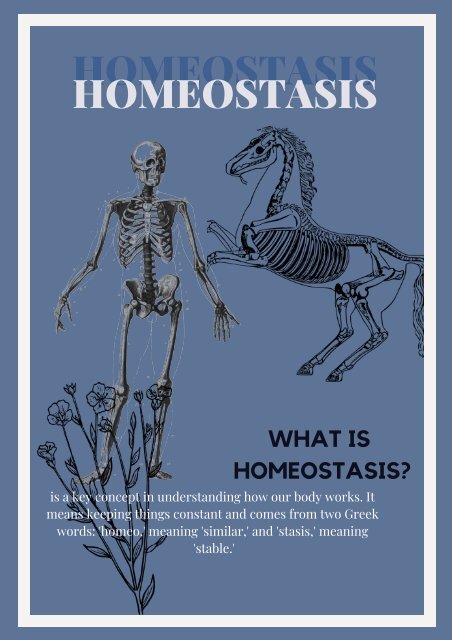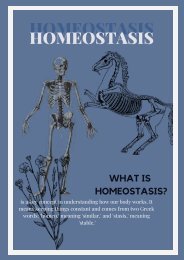HOM (1)
Create successful ePaper yourself
Turn your PDF publications into a flip-book with our unique Google optimized e-Paper software.
<strong>HOM</strong>EOSTASIS<br />
<strong>HOM</strong>EOSTASIS<br />
WHAT IS<br />
<strong>HOM</strong>EOSTASIS?<br />
is a key concept in understanding how our body works. It<br />
means keeping things constant and comes from two Greek<br />
words: 'homeo,' meaning 'similar,' and 'stasis,' meaning<br />
'stable.'
H O M E O S T A S I S<br />
I N P L A N T S<br />
.<br />
Homeostasis is the property of living<br />
organisms in which internal systems<br />
are kept in balance.<br />
Angiosperms or<br />
flowering plants<br />
maintain homeostasis<br />
by keeping their<br />
stomata (opening in<br />
the underside of a leaf<br />
that allows carbon<br />
dioxide to diffuse into<br />
and out of the leaf)<br />
open just enough to<br />
allow photosynthesis<br />
to take place but not<br />
so much that they lose<br />
an excessive amount<br />
of water. They<br />
regulate the opening<br />
and closing of their<br />
stomata to balance<br />
water loss with rates of<br />
photosynthesis.<br />
Plants stay cool in the<br />
desert heat through<br />
their reflective surfaces,<br />
reduced leaves, or<br />
leaves that are parallel<br />
to the sun. Tropism<br />
occurs when a plant<br />
grows towards or away<br />
from a stimulus. Plants<br />
must balance the heat<br />
they gain with the heat<br />
they lose.
P L A N T S A N D<br />
T H E I R<br />
S T R U C T U R E<br />
1) shoot system - above ground and includes the<br />
organs such as leaves, buds, stems, flowers (if the<br />
plant has any), and fruits (if the plant has any)<br />
TWO ORGAN<br />
SYSTEMS<br />
2) root system - includes those parts of the<br />
plant below ground, such as the<br />
roots, tubers, and rhizomes.
DERMAL<br />
TISSUE<br />
P L A N T T I S S U E<br />
T Y P E S<br />
composed of epidermal cells, closely<br />
packed cells that secrete a waxy cuticle<br />
that aids in the prevention of water<br />
loss.<br />
VASCULAR<br />
TISSUE<br />
Plant cells are formed at<br />
meristems, and then develop<br />
into cell types which are<br />
grouped into tissues.<br />
GROUND<br />
TISSUE<br />
comprises the bulk of the primary<br />
plant body. Parenchyma, collenchyma,<br />
and sclerenchyma cells are common in<br />
the ground tissue.<br />
includes xylem, phloem,<br />
parenchyma, and cambium<br />
cells
H O M E O S T A S I S<br />
I N A N I M A L S<br />
is the way animals maintain a stable internal<br />
balance in their body.It allows animals to function<br />
in the changing external conditions surrounding<br />
their body<br />
Osmoregulati<br />
on is an<br />
example of<br />
homeostasis.<br />
It is way<br />
osmosis is<br />
controlled by<br />
salmon to<br />
maintain a<br />
water balance.<br />
For warmblooded<br />
animals such<br />
as mammals<br />
and birds,<br />
homeostasis<br />
is a<br />
combination<br />
of internal<br />
processes<br />
involving<br />
hormones,<br />
the endocrine<br />
system and<br />
metabolism.<br />
Out of all six<br />
kingdoms, the animal<br />
kingdom is most<br />
likely the one that you<br />
already know the<br />
most about. After all,<br />
we are a part of this<br />
vast group. While the<br />
characteristics of<br />
animals vary greatly,<br />
there are a few things<br />
that they all<br />
share. Animals are<br />
eukaryotic,<br />
multicellular<br />
organisms that do not<br />
have cell walls, get<br />
their nutrients by<br />
ingestion, and are<br />
capable of movement.
M A I N<br />
C H A R C T E R I S T I C S<br />
O F A N I M A L S<br />
There are four main characteristics that are<br />
used to classify animals: symmetry, body<br />
cavity, tissue, and vertebral column.<br />
The first<br />
characteristic is<br />
symmetry. Animals<br />
generally fall into<br />
two categories - they<br />
either have radial or<br />
bilateral<br />
symmetry. Organis<br />
ms like sea stars<br />
have radial<br />
symmetry, while<br />
organisms such as<br />
humans have<br />
bilateral symmetry<br />
The next thing is<br />
body tissue. The<br />
more complex an<br />
organism is, the<br />
more distinctive<br />
layers of tissue it has.<br />
There are three<br />
main layers:<br />
Ectoderm - the<br />
outermost layer<br />
Endoderm - the<br />
innermost layer<br />
Mesoderm - the<br />
middle layer<br />
As for vertebral<br />
column, there are<br />
two key groups:<br />
invertebrates and<br />
vertebrates. Inverteb<br />
rates are animals<br />
without a backbone,<br />
while vertebrates are<br />
animals with a<br />
backbone. As we<br />
look at the evolution<br />
of animals, we will<br />
first look at the more<br />
simple invertebrates<br />
and then consider<br />
the more complex<br />
vertebrates.




